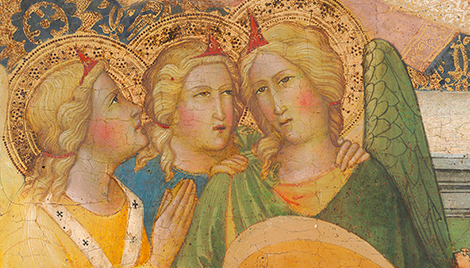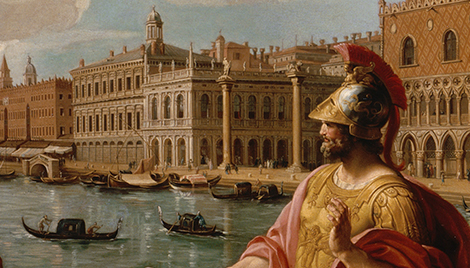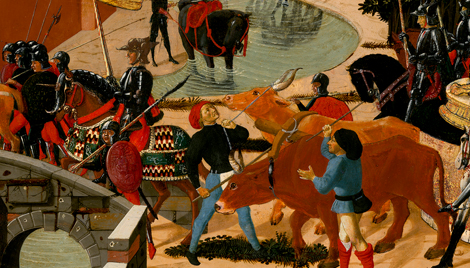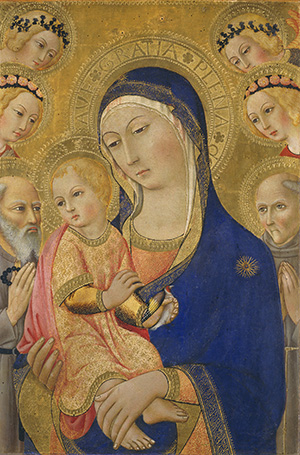Madonna and Child with Saint Jerome, Saint Bernardino, and Angels
Madonna and Child with Saint Jerome, Saint Bernardino, and Angels
- Artist
- Sano di Pietro
- Artist Dates
- 1405-1481
- Artist Nationality
- Italian
- Title
- Madonna and Child with Saint Jerome, Saint Bernardino, and Angels
- Date
- c. 1460/1470
- Medium
- tempera on panel
- Dimensions
- painted surface: 62.5 x 42 cm (24 5/8 x 16 9/16 in)
- K Number
- K492
- Repository
- National Gallery of Art
- Accession Number
- 1939.1.274
- Notes
Provenance
Family chapel of a country house at Larniano, near San Gimignano,[1] by about 1900. Count Silvio Piccolomini Clementini della Triana [1878-1962], Siena, in the 1920s and early 1930s. [2] (Count Alessandro Contini-Bonacossi, Florence); sold June 1937 to the Samuel H. Kress Foundation, New York; [3] gift 1939 to NGA. [1] A Brogi photograph (no. 11770) reproduces the painting as located in a "capella gentilizia" at Larniano, close to Siena. Actually Larniano is a locality not belonging to Siena but to the administrative district of San Gimignano (see Emmanuele Repetti, _Dizionario geografico, fisico, storico della Toscana_, Florence, 1835: 2:650, and Leone Chellini, _Sam Gimignano e dintorni_, Modena, 1921: 204-206). Chellini cites various villas in the area, some of them with private chapels, but neither he nor other authors of the late nineteenth or early twentieth centuries mention the NGA painting. The Brogi photograph is undated, but to judge from its number it must have been executed sometime before 1904; no. 15109 appears already in a volume by Corrado Ricci (_Il Palazzo Pubblico di Siena e la mostra d'antica arte senese_, Bergamo, 1904: fig. 66). [2] The bill of sale to the Kress Foundation that includes this painting (see following note) lists the painting as "From Countess Piccolomini Collection, Siena." Fern Rusk Shapley, _Catalogue of the Italian Paintings_, 2 vols., Washington, D.C., 1979: 1:413, gives Count Silvio Piccolomini as the former owner. In his expertise (in NGA curatorial files) written probably in 1937, F. Mason Perkins confirms that the panel used to belong to the Piccolomini family: "in one of whose palaces at Siena it was still hanging when first known to me." The fact, communicated to Mrs. Shapley by Everett Fahy (letter of 25 August 1972, in NGA curatorial files), that a copy of the NGA painting, made by A. Everett Austin, Jr. [1900-1957], and now in the Fogg Art Museum in Cambridge, Massachusetts, no. 1926.49, has on its back a handwritten note by the Museum's former director, Edward Forbes, possibly offers further information toward a reconstruction of the painting's history. Forbes writes: "I think it was painted by Austin in the studio of Federigo Ioni, Siena, about 1924." The Fogg copy was possibly made to replace the original in the Larniano chapel, and not utilized. In any case, by the mid-1920s the NGA painting must already have been in Siena, in one of the Piccolomini palaces. [3] The bill of sale for a number of paintings and one sculpture, including NGA 1939.1.274, is dated 18 June 1937 (copy in NGA curatorial files).






